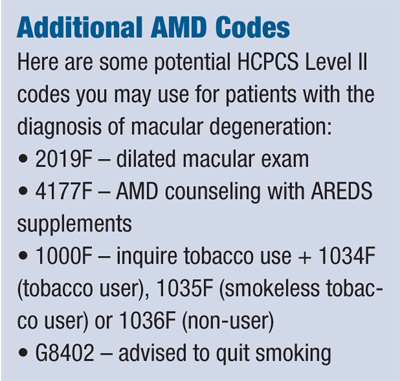Effective January 1, 2011, significant coding changes have affected the special ophthalmic tests of Scanning Computerized Ophthalmic Diagnostic Imaging (SCODI).


Specifically, CPT code 92135, “Scanning computerized ophthalmic diagnostic imaging, posterior segment, (e.g., scanning laser) with interpretation and report, unilateral,” has been eliminated.
But three new CPT codes were made effective to replace and increase specificity of the testing:
• 92132. Scanning computerized ophthalmic diagnostic imaging, anterior segment, with interpretation and report, unilateral or bilateral. (This replaces the CPT Category III code 0187T.)
• 92133. Scanning computerized ophthalmic diagnostic imaging, posterior segment, with interpretation and report, unilateral or bilateral; optic nerve.
• 92134. Scanning computerized ophthalmic diagnostic imaging, posterior segment, with interpretation and report, unilateral or bilateral; retina. This is the CPT code now used for patients with macular degeneration. Remember that 92135 was billed once per eye, but the new codes are only billed once whether you scan both eyes or just one eye.
Medicare considers 92133 and 92134 mutually exclusive, so they cannot be billed on the same day, regardless of diagnosis. Additionally, in many areas, 92132 is also considered to be inappropriate to do on the same day with either of the posterior segment procedures. Check your local LCD or use a service (such as www.LCDPlus.com or CCIPlus.com) to keep up-to-date on your local regulations and Correct Coding Edits. Also recognize that many other medical carriers have not yet adjusted their policies to these new codes and may still list 92135 as a viable billing code until their policies are revised.
Fundus Photos and More
Fundus photography with interpretation and report (92250) is the CPT code used for retinal photos. Fundus photography is used to compare and track changes in the retina. It can assist you with treatment and management decisions. Fundus photography is not usually covered just to document the existence of a condition, but to be used as baseline and to monitor change or confirm stability. The frequency of fundus photography should be determined by “medical necessity.”
Fundus photography with interpretation and report (92250) is a bilateral code by definition. So, you don’t need to use a -50 modifier or the -RT and -LT modifiers. You’ll get paid for both eyes when you list the 92250 CPT code. However, if you’re performing fundus photography on just one eye, then indicate this by using the -RT or -LT modifier and reducing your fee accordingly.

Newer diagnostic technologies, such as heterochromatic flicker photometry with QuantifEYE (ZeaVision) or the MacuScope (Marco), are not covered by Medicare. Preferential hyperacuity perimetry with the Foresee PHP (Reichert) may or may not be covered by Medicare. If covered, it is generally billed with the visual field code 92082.
With the incidence of macular degeneration projected to increase and with newer therapies to combat and prevent it, appropriate clinical testing is vital to your practice. Audit triggers are fairly prevalent with the special ophthalmic testing discussed here, so please make sure that you have a good knowledge of your local rules and guidelines, and that your medical records are in good order.

